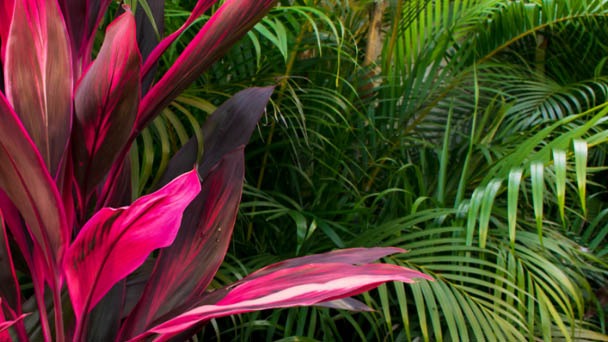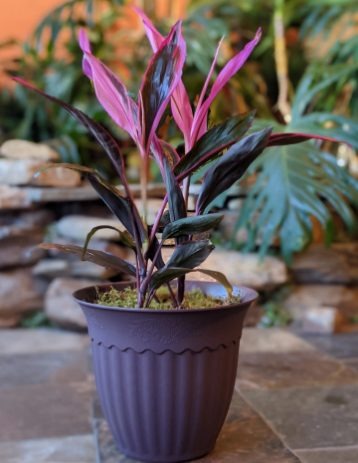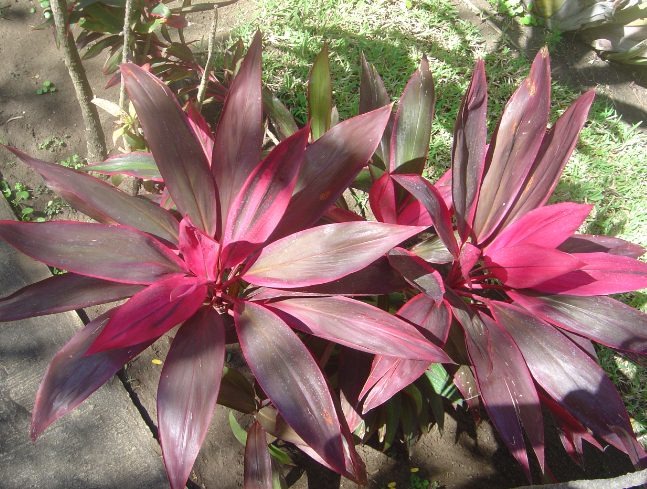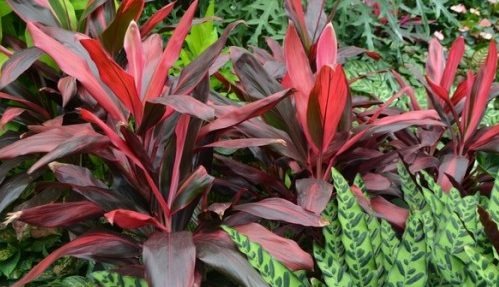How to Grow and Care for Red Sister Plant
Written by Ivy
Jan 21 2023

Southeast Asia, eastern Australia, and Oceania are home to the stunning Asparagaceae family member known as the Cordyline Red Sister.
There are numerous varieties of this plant with leaves that are maroon, pink, burgundy, and green that, in ideal circumstances, grow to a height of 4-6 feet. The leaves measure 4-6 inches in width and 12-30 inches in length.
What is Red Sister Plant?

The Ti plant, also referred to as the Cordyline Red Sister Plant, produces leathery, spear-shaped leaves in a range of colors. The evergreen shrub's leaves can be any color, including green, red, yellow, white, purple, or purplish-red. Early in the summer, some cordyline plant varieties produce white, pink, or lavender flowers with berries.
Both outdoor and indoor cordyline varieties are hardy. Although flowering is more likely in outdoor varieties, cordylines can also occasionally produce flowers when grown indoors. The cordyline plant is indigenous to Hawaii, other Pacific islands, eastern Australia, and southeast Asia.
The dracaena family member cordyline is a tropical plant, and it prefers climates with average daily temperatures above 55°F. A very sunny location is ideal for a cordyline plant indoor houseplant.
Cordyline Red Sister Care
Size & Growth
There are numerous Ti plant varieties among the Cordyline plants, some with maroon and green leaves, some with hot pink tips, and some with variegated leaves.
Particularly colorful foliage with burgundy to pinkish leaves can be found on the Red Sister Ti plant.
The leaves are around 12" to 30" inches long and 4" to 6" inches wide.
In the best circumstances, the red sister plants can reach heights of 4 to 6 feet.
Flowering and Fragrance
When the Red Sister is allowed to grow in its natural habitat, it will occasionally produce tiny pink, purple, or white flowers.
Late spring to early summer is when this plant blooms.
These beautiful flowers grow in clusters and are 0.5" inches wide.
Indoor plants don't bloom, though.
Occasionally, it will also produce a fruit that resembles red berries.
Light & Temperature
The Cordyline fruticosa Plant does well in bright light as a houseplant.
The foliage will appear more vibrant as it receives more light.
The best exposure is to the south or east, though it can also tolerate some shade.
It does well when planted outdoors in full sun, but it needs protection from the wind.
In order to protect the plant's leaves from burning if the sun is too strong, it is best to place it in a small area of partial shade.
This plant's USDA hardiness ranges from zones 9 to 12.
Watering and Feeding
- Since it prefers to grow in moist soil, this plant requires routine watering.
- The soil should, however, be allowed to slightly dry out before being watered.
- Do not overwater the plant.
- Feed the plant every three months.
- Give outdoor plants a slow-release fertilizer while feeding indoor plants a liquid fertilizer that is half its normal strength.
Soil & Transplanting
The Ti Plant prefers a well-draining, rich potting mix but can tolerate poor and dry soil conditions.
To make sure the plant receives the right nutrients for growth, you should repot it every three to four years and change the soil's top layer every year.
Ensure that the new plant's pot is slightly larger than the old one.
Grooming and Maintenance
Sometimes upkeep is needed for this plant.
Don't forget to humidify the plant for glossier, more vibrant foliage.
As it may encourage leaf diseases, avoid overhead watering.
In cold weather, Cordyline Red Sister needs to be protected.
Wait until the spring season arrives to prune back the stems that were harmed by the cold.
How to Propagate Cordyline Red Sister
Seeds and stem cuttings are used to propagate this plant.
When using seeds, make sure to soak them in warm water for approximately ten minutes prior to planting.
In between one and three months, seeds will germination.
When the seedlings are big enough to handle, plant them in individual pots.
Water them regularly, and when they are about 4" inches tall, transplant them in their permanent position.
When using tip or stem cuttings:
- Take the cutting from a mature plant, just below the plant's head.
- The cuttings should be 3" to 5" inches long at a minimum.
- For tip cuttings remove the bottom leaves and dip the stem in rooting hormone powder
- Plant tips in a well draining potting soil – plant bare stems 1" inch deep in the potting soil.
- Keep the plant moist and in a shaded area until it develops a solid root system.
- Place the roots in individual pots once they have formed.
Propagation by Division
Slice up a sturdy cane into pieces that are between one and two inches long. Put these cuttings in containers with new, drained soil. The cuttings should be buried in the ground with the exposed side facing up.
Place the pots in a warm area of your home with some shade, and mist the soil in the pots several times each day.
Within 4-6 weeks, the emergence of new roots and shoots will begin. As long as the pots are the right size, you can either move the plants into bigger containers or keep growing them in the original ones.
Since the roots and stems are simply divided into two or more sections, this technique is much simpler than stem cutting. Each new section should be planted in pots of drained soil.
Propagation from Air Layering
It's not too difficult to carry out this propagation practice. A healthy branch that is growing from the plant can be wounded to encourage the growth of roots.
Make a circular cut in the bark just below a node around the stem, and then make another one similar to the first one a few inches lower.
Then, make a straight cut to separate the bark, and join the two wounds. In order to remove the inner, slick bark from the stem, you should have a circular area of the stem that is bare; failing to do so will stop the wound from healing.
The exposed area should be covered with a handful of wet moss or cocoa powder, which should then be wrapped in a clear plastic sheet and tied off at the ends to the stem. You can use this to determine when rooting begins.
Once the new roots have begun to take hold, trim the stem below them, take off the plastic cap, and plant in a fresh container.

Cordyline Red Sister Plant Pest Or Diseases
In particular, mealy bugs, scales, and spider mites should be kept an eye out for on the plant.
Spray organic Neem oil or insecticidal soap on the lower and upper leaf surfaces to get rid of pests.
Common Problems
Although it can be harmed by mites, mealybugs, fungus gnats, scale, and thrips, it is a tough plant. Leaf loss, stains, and/or stunted growth are the typical signs of pest infestations.
These can be dealt with using insecticidal soap or neem oil, and then the plant can be sprayed with water to remove any remaining eggs.
Chemicals, leaf spot, color loss, root/stem rot, and bacterial infections are a few problems that can affect the plant.
Leaf tip burn from tap water fluoride is a frequent occurrence that can result in necrosis. Another issue that can be avoided by watering the plant's base and avoiding getting water on the foliage is leaf spot.
Leaf fading is another frequent issue. Insufficient lighting and overfertilization are frequent contributors to this. For the foliage of this plant to remain vibrant and improve in color, bright light is required.
It will be possible to revive drab foliage by reducing fertilizer application and dosage.
If a plant becomes infected with bacteria, there isn't much that can be done for it other than tossing it out right away. Black roots, slimy, wet leaves, or spots that are tan, purple, or reddish-brown on leaves or stems are all signs of bacterial infection.
Brown leaves can result from a variety of problems, including overwatering, excessive sun exposure, or excessively warm temperatures.
First, make sure you are adhering to the suggested watering schedule and that the planting medium is draining well before you start troubleshooting each potential problem.
The plant needs to be moved out of direct sunlight as the next course of action. Last but not least, make sure the temperature doesn't go above 95 degrees Fahrenheit.
The plant is being burned by direct sunlight if its leaves are yellow. Change the plant's location to one that receives lots of indirect light.
The lower leaves of the plant may occasionally start to dry out and fall off if it isn't given enough water. If the weather is dry or arid, change the watering schedule and think about misting the plant frequently.
Cordyline Varieties
There are numerous varieties of the cordyline plant, most of which have vibrant leaves. Your cordyline plants may reach a height of almost a foot, depending on where you intend to place them.
- Cordyline fruticosa: This variety has glossy, multicolored leaves that vary depending on the cultivar. Also known as Cordyline terminalis, the trunk grows straight up and can be up to 10 feet tall.
- Cordyline pumilio: This New Zealand-grown variety, which is used to sweeten food and is also known by the common names dwarf cabbage tree and pygmy cabbage tree, is also known by these names. It only reaches a height of 3 feet, has no trunk, and, to the untrained eye, appears to have grass-like green leaves.
- Cordyline Australis: The early summer blooming white flowers of the Red Star plant are surrounded by large, pointed red leaves that are arranged in a circle. The Red Star Ti plant prefers partial sunlight rather than full sunlight, along with a dry climate and lower humidity levels than other cordyline varieties. The Red Star requires a very deep container for planting because of its long tap root.
- Cordyline Electric Pink: This cordyline variety's shocking pink long, pointed leaves stand out in any garden. It is much more tolerant of colder temperatures and can survive in temperatures as low as 15°F.
- Cordyline Red Sensation: a similarly vibrant cordyline variety with long red leaves. This hardy variety of cordyline can flourish as a tiny houseplant or develop into a sizable shrub outdoors in a sizable pot. It is extremely resilient to both drought and cold temperatures.
- Cordyline Red Sister: The Hawaiian Ti plant, also known as Red Ti, was once known as the good luck plant and is easily recognized by its dark green and deep pink leaves. The Red Ti grows best outside in tropical climates with regular watering and moist soil.

Conclusion
A cordyline can grow both inside and outside in the warmest areas. Your cordyline should only be an indoor houseplant if you don't live in a warm, tropical area. Luckily, these plants are fairly easy to grow indoors and add both color and interest to your houseplant collection.
Latest Updated
- Benefits of Bugleweed - 7 Science-backed Health Benefits
- Bugleweed Dangers & Side Effects - Is It Poisonous?
- How to Plant Evergreen Trees - What You Should Know
- When to Plant Evergreens - Grow Guide for Evergreen Trees
- 12 Wonderful Evergreen Shrubs for Your Garden
- 12 Popular Evergreen Plants with Pictures for Beginners
- When And How To Prune A Lilac Bush Like a Pro
- How to Grow & Care for Lilac Vine (Hardenbergia Violacea)
- Japanese Lilac Tree (Syringa Reticulata) Care & Propagation Guide
- Shumard Oak Pros and Cons - What to Know
Popular Articles
- Winter maintenance of Antirrhinum Majus
- How to Grow Terminalia Mantaly Tree
- How to Grow and Care for Crossostephium Chinense
- How to grow Antirrhinum Majus in spring
- Peristeria Elata (Dove Orchid) Profile: Info & Care Guide
- Underwatered Snake Plant (Sansevieria Trifasciata) - Signs And How To Fix
- How to Care for Brazilian Jasmine Plant (Mandevilla Sanderi)
- How to Grow & Care for Graptopetalum Purple Delight in Summer
- Rosa Chinensis (China Rose): Plant Growing & Care Tips
- How to Care for Baby Sun Rose (Aptenia Cordifolia)